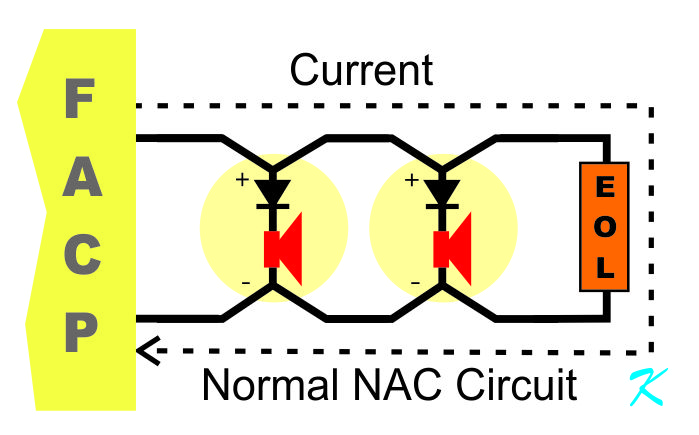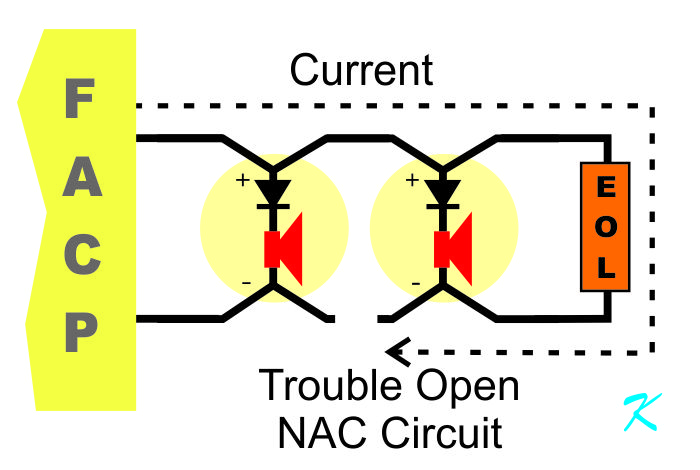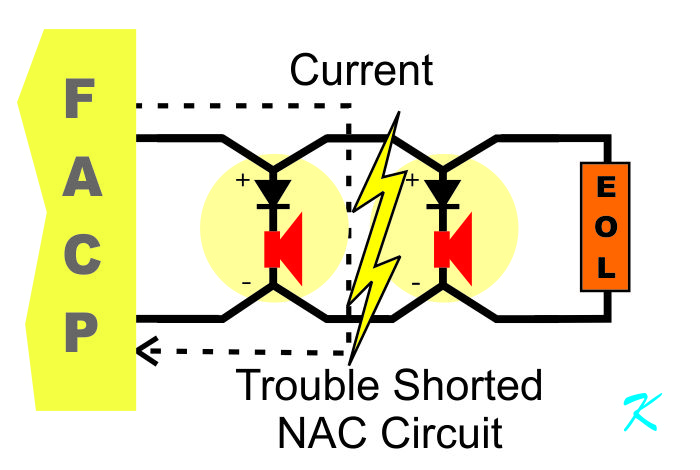
Fire alarm systems are more than just the Fire Alarm Control Panel (FACP) on the wall; fire alarm systems are all over the building in order to detect fires and sound the alarm.
NAC2 is the alarm part. It's a Notification Appliance Circuit, or output circuit, that carries power to the horns and strobes in then building. It is a pair of wires attached to the NAC2 screw terminals on the panel, and has horns and/or strobes connected. It also has an End of Line Resistor.
For a NAC circuit, there are three conditions:
Normal - All NAC devices are connected
Trouble Open - Some or all NAC devices are not connected
Trouble Short - The NAC circuit is shorted and will not work at all
Normal NAC Circuit
Under normal circumstances, when the alarm is not sounding off, the panel is supervising the wires of the NAC circuits. In other words, the panel is making sure the wires are connected to all the horns and strobes on the circuit.
It does the supervision, or making sure everything is connected, by passing a small electrical current through all the wires, and through a resistor at the end of the circuit (End of Line Resistor). The panel checks the continuity of the wires.
If NAC1 isn't in trouble, use your voltmeter and measure the voltage on the NAC1 screw terminals on the panel. That is the correct voltage, and you can use that voltage for comparison when checking NAC2.
Trouble Open NAC Circuit

If a wire is not connected to a horn or strobe that should be connected, or a wire breaks, the current stops. There is a "Trouble NACx" on the panel.
You can use your voltmeter to confirm this. When the panel is not sounding the alarm, the voltage on the NAC2 screw terminals of the control panel will be higher than the voltage on the NAC1 screw terminals.
If the voltage on NAC2 is high compared to NAC1, find and fix the connection that has come loose, or the device that is not connected, or the broken wire. It's somewhere in the building. If this is a new building, something may have been missed during construction or installation.
Trouble Shorted NAC Circuit

I there's a wire-to-wire short, the panel won't even try to sound the alarms on the NAC2 circuit. The panel may say "Trouble NAC2", or it may say something like "Trouble Short NAC2".
You can use your voltmeter to confirm this. When the panel is not sounding the alarm, the voltage on the NAC2 screw terminals of the control panel will be much lower than the voltage on the NAC1 screw terminals. The NAC2 voltage may even be zero volts.
If the voltage on NAC2 is low compared to NAC1, find and fix the connection that is shorted, or the wires that have been shorted. If this is a new building, something may have been missed during construction or during the installation.
Voltage Reversal When Sounding the Alarm
Get over thinking that the red wire is positive and the black wire is negative. A NAC circuit just doesn't work that way. Use your meter to figure out the polarity.
Be careful, though, when measuring the voltage at the horn or strobe. When the panel is sounding the alarm, the voltage polarity on the wires to the horns and strobes is correct.
The wire you measure as Positive is the wire that connects to the Plus terminal on the horns and strobes: the wire you measure as Negative is the wire that connects to the Minus terminal. When the alarms are sounding, this allows current to flow through the horns and strobes.
When the panel is not sounding the alarm, the voltage on the wires is backwards. The current isn't supposed to go through the horns and strobes, so the polarity on the wires is wrong.
The wire you measure as Positive is the wire that connects to the Minus terminal on the horns and strobes: the wire you measure as Negative is the wire that connects to the Plus terminal. When the alarms are not sounding, this prevents current from flowing through the horns and strobes.
Somewhere in the Building
The problem you're seeing is somewhere in the building. It's probably not at the panel, but don't rule that out.
There even may be more than one problem with the building's NAC2 circuit. Once all the wiring problems with the circuit are fixed, the NAC2 trouble will disappear.
OK. You may also have to press reset on the panel, sometimes the trouble signals latch-on at the panel and have to be reset after the trouble is fixed.
Douglas Krantz




